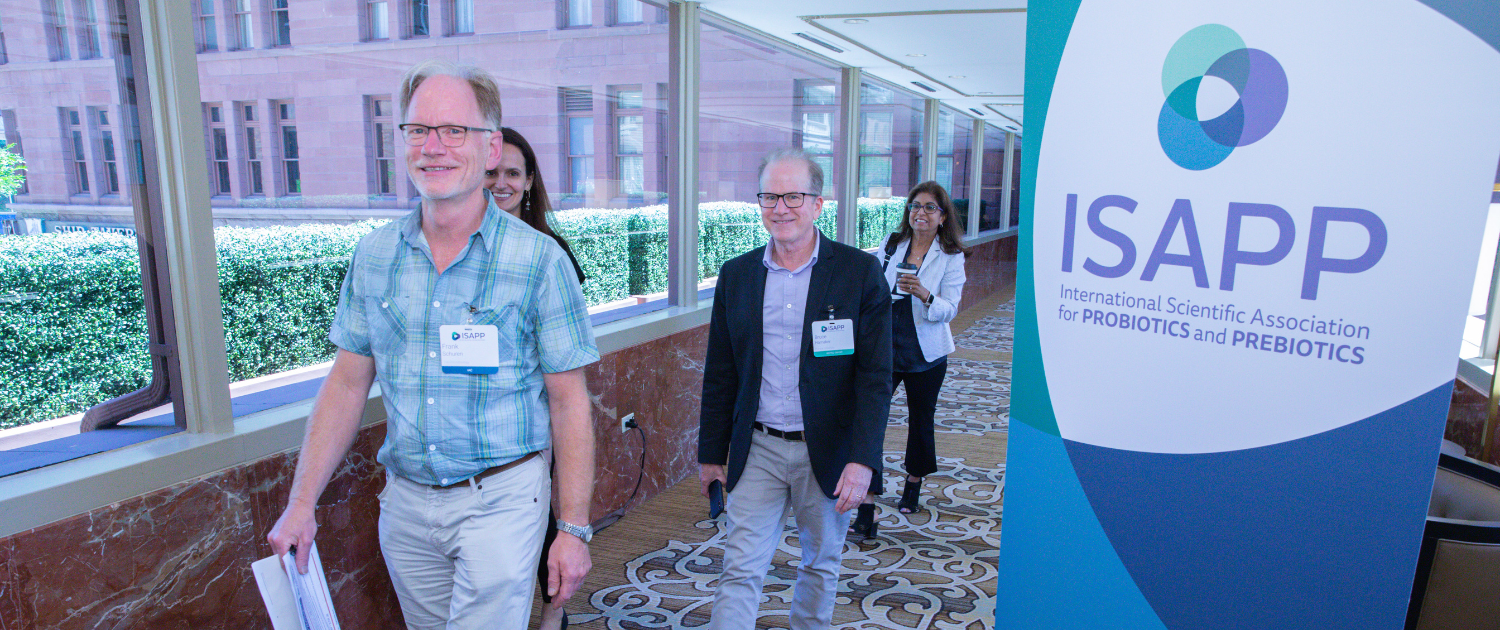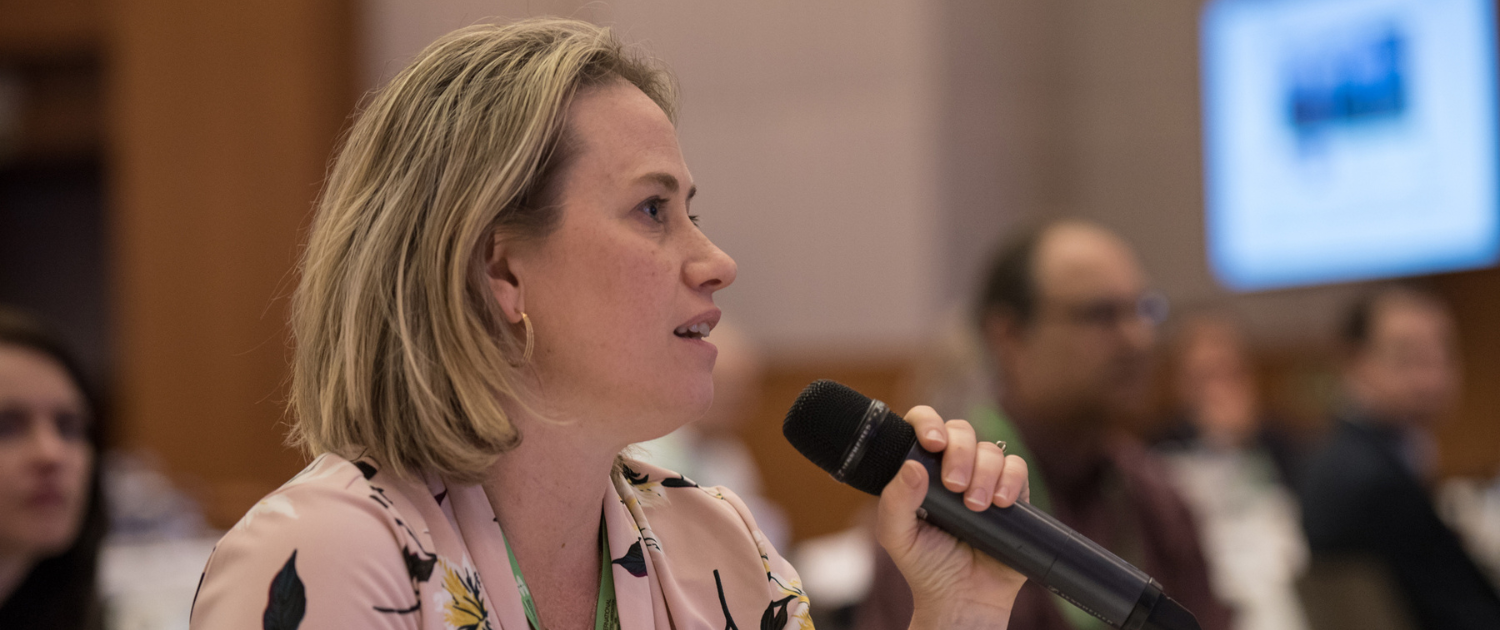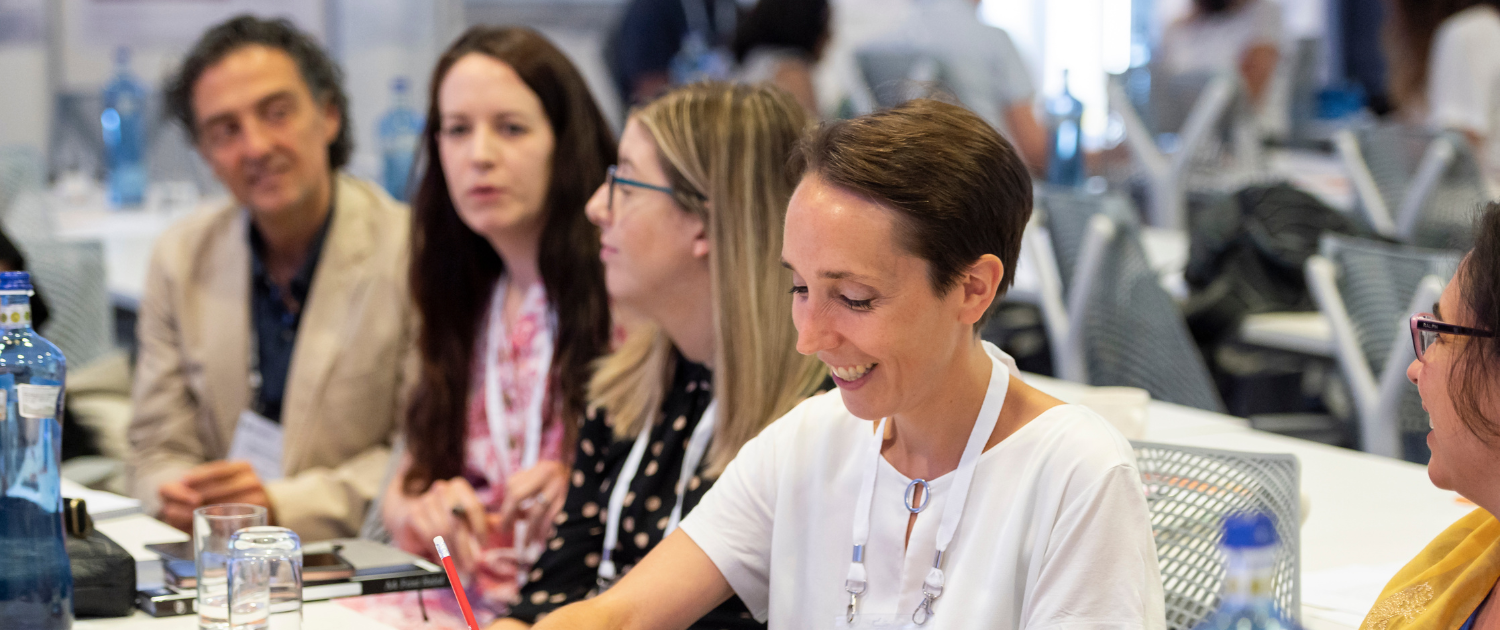ISAPP’s annual meetings are opportunities to share scientific research and progress in the fields of probiotics, prebiotics, synbiotics, postbiotics, fermented foods, and microbiomes. An international group of top researchers, key opinion leaders, industry scientists, and students come together to share developments and discuss challengest to the future of the field.
Participation in ISAPP’s annual meetings is often limited to invited experts, industry member representatives, and members of the ISAPP Students and Fellows Association, but open-registration meetings are also occasionally convened.
See below for the reports and follow up from ISAPP’s annual meetings.
2025 BANFF, CANADA
- 2025 Meeting Report
- Meeting Content (for attendees only)
2024 CORK, IRELAND
- 2024 Meeting Report
- Meeting Content (for attendees only)
2023 DENVER, CO, USA
- 2023 Meeting Report
- Meeting Content (for attendees only)
2022 SITGES, SPAIN
- 2022 Meeting Report
- Meeting Content (for attendees only)
2021 VIRTUAL MEETING
- Meeting Report
- Meeting Content (for attendees only)
2020 VIRTUAL MEETING
- Meeting Report
- Meeting Content (for attendees only)
2019 ANTWERP
- Meeting Report
- 2019 Meeting Follow Up (for attendees only)
2018 SINGAPORE
- Meeting Report
- 2018 Meeting Follow Up (for attendees only)
2017 CHICAGO, IL, USA
- Meeting Report
- 2017 Meeting Follow Up (for attendees only)
2016 TURKU, FINLAND
- Meeting Report
- 2016 Meeting Follow Up (for attendees only)
2015 WASHINGTON DC, USA
- Meeting Report
- 2015 Meeting Follow Up (for attendees only)
2014 ABERDEEN, SCOTLAND
- Meeting Report
- 2014 Meeting Follow Up (for attendees only)
2012 CORK, IRELAND
- Meeting Report
- Meeting Follow-up (for attendees only)
2011 BERKELEY, CA, USA
2010 BARCELONA, SPAIN
- Meeting Report
- Summaries of Discussion Groups
- Meeting Information (for attendees only)
2009 IRVINE, CA, USA
2008 LONDON, ON, CANADA
- Meeting Report
- Handouts (for attendees only)
2007 LONDON, UK
- Meeting Report
- Presentations (for attendees only)
2006 COLERAINE, NORTHERN IRELAND
The International Scientific Association for Probiotics and Prebiotics (ISAPP) convened a 4th by-invitation meeting June 16-18, 2006. Hosted by Dr. Ian Rowland on the campus of the modern University of Ulster, Coleraine, Northern Ireland, 84 scientists from 19 countries and four continents. The meeting included four presentations in the Plenary Session by Jeff Leach (Paleobiotics Lab, Silver City NM), Alexander Swidsinski (The University Hospital Charité of the Humboldt University of Berlin, Germany), Phil Sherman (Hospital for Sick Children, University of Toronto, Canada), and Lesley Houghton (University of Manchester, UK). This Plenary Session was followed by an informal session highlighting controversies in the probiotic and prebiotic fields, and a Late Breaking News session featuring 5 minute talks by selected scientists on new developments in their laboratories. The signature event for these meetings is discussion sessions which were held the following day on the topics of: Probiotics as anti-infectives: prevention and adjunct therapy, chaired by Gregor Reid; Influence of culture preparation, delivery matrix and encapsulation/co-encapsulation on probiotic and prebiotic functionality, co-chaired by Paul Ross and Claude Champagne; Probiotics and prebiotics for the control of colorectal cancer: facts and promises, co-chaired by Ian Rowland and Francisco Guarner ; Mechanisms of gut flora, probiotic and prebiotic influence on sites distant from the intestinal tract, co-chaired by Mary Ellen Sanders and Irene Lenoir; Animal uses for probiotics and prebiotics: impact on antibiotic use, chaired by Bob Rastall; Functional genomics of probiotics, chaired by Jim Versalovic; and What determines the bacteria we inherit?, co-chaired by Glenn Gibson and Karen
Scott. A report from the 2006 meeting titled “Probiotics and prebiotics – strain selection, dosage, functionality, omics and applications” has been prepared by Gregor Reid and submitted for publication in Trends in Microbiology. Other publications summarizing conclusions from certain individual groups are also forthcoming. Click here for the complete 2006 scientific program
2005: REMOTE MINI-SYMPOSIA
In 2005, the ISAPP Board of Directors decided to try to expand ISAPP’s reach beyond the past presence in North America and Europe. Especially of interest was to expand scientific communication to regions of the world not easily able to participate in state-of-the-art conferences on probiotics and prebiotics. Toward this end, we are now pleased to report that we have helped set up or will be participating in conferences or mini-symposia in several locations:
Asia:
- 3rd Asian Conference for Lactic Acid Bacteria & 9th National Congress of Indonesian
Society for Microbiology, Indonesia August 2005
download report
Download ISAPP-sponsored abstracts: Gill Gopal Crane Crittenden
Eastern Europe:
- European Conference on Probiotics and their Applications, Poland October 2005
http://confer.uj.edu.pl/euprobio
download report
Africa:
- 18th International Nutrition Congress, Gastroenterology – Probiotics and beneficial
impact on health, S. Africa, September 2005
download report
North America:
- American Academy of Microbiology Colloquium, Probiotic Microbes: The Scientific
Basis, November 2-5, 2005, Baltimore, Maryland, USA
download report
- International Union of Microbiological Societies, symposium titled “Probiotic Functions
of Microorganisms”, July 27, 2005 San Francisco, California, USA
download report
In addition to these activities, we are exploring additional action items:
- Development of small working groups to explore ‘best approaches’ for evaluation
of efficacy for probiotics and prebiotics in human studies. This activity is in
the conception stage. Initially, the target of allergy was chosen as an endpoint.
We would like to try to identify a time and location in the US in the fall to convene
about 5 clinical researchers, 5 interested industry scientists, several ISAPP scientists
(total maximum about 15 people) to meet for a day to discuss best clinical approaches.
If this pilot goes well, we would hope to convene groups with different targets,
such as intestinal microbiology, wellness, etc. - Collaborating with WHO/FAO to develop a Codex ‘standard of identity’ for the
use
of the term ‘probiotic’. If adopted, products using this term on product labels
would have to meet certain minimum criteria of safety, product composition and efficacy.
2004 COPPER MOUNTAIN, CO, USA
3rd Meeting of ISAPP Held in Colorado August 28-31, 2004
The International Scientific Association for Probiotics and Prebiotics (ISAPP) met for the 3rd time to discuss the latest scientific developments in this rapidly growing field. This by-invitation meeting, surrounded by the grandeur of the Rocky Mountains in Copper Mountain Colorado August 29-31 2004, convened 84 invited scientists from 13 countries. Presentations by Joel Weinstock (University of Iowa), Thadeus Stappenbeck (Washington University School of Medicine), Connie Weaver (Purdue University), Ian Rowland (Northern Ireland Centre for Food and Health) and Peter Lee (Stanford University) covered a range of topics from use of helminthes to modulate immune dysregulation to probiotics bioengineered to improve resistance to HIV. Discussion sub-groups were convened for a full day on the topics of Engineered probiotics as therapeutics: formats and challenges; Host commensal interactions – who talks to whom and how; Omics technologies – exploration of the interaction of pro and prebiotics with the host; Hygiene and immune regulation; Biomarkers for healthy people; Prebiotic and probiotic applications to companion animals; Development of a probiotic dossier using science-based criteria and Physiological relevance of prebiotic activity. A report from the 2004 meeting has been prepared and submitted for publication (Sanders, ME, Guarner, F, Mills, D, Pot, B, Rafter, J, Rastall, R, Reid, G, Ringel, Y, Rowland, I, Saarela, M, and Tuohy, K. Selected Topics in Probiotics and Prebiotics: Meeting Report for the 2004 International Scientific Association for Probiotics and Prebiotics. Current Issues Intestinal Microbiol., Submitted)
In addition to the academic participants, about 25 industry scientists participated in the meeting. Twenty companies committed to science-driven probiotic and prebiotic product development contributed financially and scientifically to the meeting. Most companies are members of the ISAPP Industry Advisory Committee. This body interacts closely with the ISAPP Board of Directors, identifying key scientific issues important to the advancement of this field.
ISAPP is a non-profit scientific organization incorporated in 2002. Meetings of ISAPP were held in Ontario Canada in 2002 and Henley-on-Thames , UK in 2003. More information on this organization can be found at the ISAPP website.
- Click here for the complete 2004 scientific program
- Click here for press release
2003 HENLEY, UK
- The 2003 meeting of ISAPP was held August 3-5 in Henley-on-Thames outside of London UK. 70 scientists from 20 countries convened for general lectures and in 7 smaller discussion groups to discuss clinical study design/biostatistics (chaired by Ian Rowland), Probiotics and prebiotics: the potential to impact worldwide health (chaired by Gregor Reid), Genotype vs. phenotype (chaired by Todd Klaenhammer), Biotechnology, stability, manufacture, biotechnological presentation of prebiotics and synbiotics (chaired by Bob Rastall), Weight of evidence for a probiotic/prebiotic effect: what is needed? (chaired by Mary Ellen Sanders), Pathogen modulation (acute and chronic illness mediated by pathogens) – what is the direct action of pro/prebiotics? (chaired by Harsharn Gill), Probiotics and prebiotics through life – age relationships, use in infants, weaning, elderly (chaired by Glenn Gibson). The discussion from this meeting have been summarized and submitted for publication (Rastall, R., Gibson, G., Gill, H., Guarner, F., Klaenhammer, T., Pot, B., Reid, G., Rowland, I., Sanders, M.E. Modulation of the microbial ecology of the human colon by probiotics, prebiotics and synbiotics to enhance human health: an overview of enabling science and potential applications. FEMS Microbial Ecology.)
- Conclusions from the 2003 group on “Weight of evidence for a probiotic/prebiotic effect: what is needed?” was published: Sanders ME, Tompkins T, Heimbach JT, Kolida S. 2004. Weight of evidence needed to substantiate a health effect for probiotics and prebiotics. Regulatory considerations in Canada , E.U., and U.S. Eur J Nutr. Sep 2; [Epub ahead of print]
- Concise responses to industry questions on immune biomarkers, gut flora improvement, probiotic dose, D,L-lactate, ‘human origin’ for probiotic strains, undefined probiotics, live vs. dead probiotics, definition of prebiotics and prebiotics with proven effects can be found here.
2002 LONDON, ON, CANADA
ISAPP convened an inaugural by-invitation workshop in London, Ontario May 3-5, 2002. A report on this meeting was published:
- Reid, G, M. E. Sanders, H. R. Gaskins, G. Gibson, A. Mercenier, R. Rastall, M. Roberfroid,
I. Rowland, C. Cherbut, and T. R. Klaenhammer. 2003. New Scientific Paradigms for
Probiotics and Prebiotics. Journal Clinical Gastroenterology. 37(2):105-118
Groups from the 2002 meeting:
- Definitions and Standards (report, group participants)
- Immune (report, group participants)
- Genetics (photo,
report, group participants) - Intestinal Microbiota and Dietary Modulation (photo, report, group participants)
- Cancer (photo,
report, group participants) - Extra-Intestinal Sites (photo)
- Second Generation Prebiotics (report, group participants)
- Intestinal Disease (group participants) (report not available: submitted for publication elsewhere)









